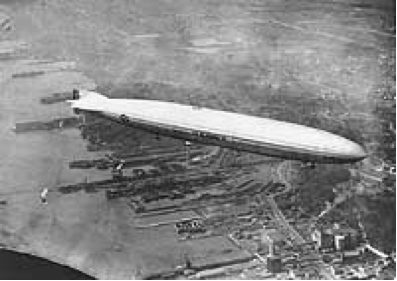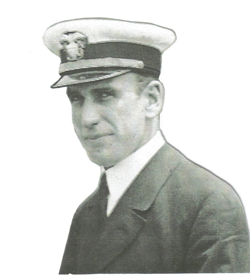The USS SHENANDOAH is no more.
(1923 -1925)

The Shenandoah was the first zeppelin built in the United States for the US Navy using duralumin construction and helium gas. Its overall length was 680 feet with a cruising range of 2,770 nautical miles and a top speed of 60 mph. The flight crew consisted of 40 officers and enlisted men. Its purpose was to be the eyes of the Navy, scouting for enemy ships at sea from high in the sky.
Lieutenant Commander Zachary Lansdowne was born in Greenville, Ohio, on December 1, 1888. He entered the United States Naval Academy in 1905 and graduated in 1909 along with Halsey and Nimitz. He then received aeronautical instruction at Pensacola, Florida, and Akron, Ohio. In September 1917, Lansdowne was sent to England for training in the operation of dirigibles. He spent the rest of the World War, and the first months of 1919, at air stations in France.

In July 1919, LCdr. Lansdowne served on board the British rigid airship R-34 during its historic non-stop flight across the Atlantic from Scotland to Long Island, New York. He was Assistant Naval Attaché in Germany in 1922-1923, during which time his duties involved negotiations that resulted in the construction of USS Los Angeles, the Navy's second rigid airship. He then took command of USS Shenandoah early in 1924. Over the next year and a half he carried out an energetic development program with her, including operations at sea and a trans-Continental flight from New Jersey to California.
All of America was in love with the sight of the Shenandoah and letters and telegrams arrived at Navy headquarters from Congressmen, airport promoters, city officials and the established “doers” of the Nation, requesting the graceful silver airship to fly over various cities during the first week of September 1925. Orders were sent to Lansdowne to schedule a midwest tour of nearly 3,000 miles. The trip was to begin at Lakehurst, New Jersey, and visit several cities including St. Louis, Minneapolis, and Detroit, as well as state and county fairs at Columbus, Des Moines and Milwaukee. Lansdowne worried that high temperatures and thunderstorms might be a problem, but his request to delay the tour until the second week in September was not approved. So at 2:52 pm on Wednesday, September 2, 1925, the USS Shenandoah took off from Lakehurst and headed west, crossing over Somerset, Pennsylvania, and Wheeling, West Virginia. The trip was uneventful that afternoon and evening, but early the following morning, despite the best weather reports available, the airship found itself caught in a freak rain storm over Cambridge, Ohio, that it was unable to steer around.
SHENANDOAH BREAKS INTO PIECES
IN OHIO STORM,FOURTEEN KILLED
Giant Airship Breaks Into Three Pieces When She Hits
Line of Squall, Crew Works Heroically in Vain.
Caldwell, O., Sept. 3 – The Giant dirigible Shenandoah is no more. It went down in three pieces here early today and killed its commander, Lieut. Commander Zachary Lansdowne, and at least 13 of the officers and men making up her crew……..(this is what the citizens of Youngstown read in the final edition on Thursday. Here is what was learned later from official reports and testimonies of the survivors.)
The ship was unable to escape from the storm and lurched from 3,000 feet to 6,060 feet only to plummet back to 2,500 feet. At the direction of Captain Lansdowne, the crew tried all of the emergency procedures, venting helium during the ascents and dropping ballast during the descents, while the rudder and elevator men in the control car tried desperately to stabilize the ship. At about 4:50 am, a sudden, strong upward gust struck the ship. The stress imposed by this gust, combined with the uncontrollable pitching of the ship, caused it to twist apart. The steep upward angle of the front section caused such stress on the struts holding the control car that it broke away and plummeted to earth, killing Captain Lansdowne and eleven other officers and men in the car.
Today you may view the crash scene without leaving your car. Driving south on Interstate 77, stop near Mile Marker 33 (12 miles south of Cambridge) and look over the guard rail. You will see the outline of the rear section of the Shenandoah that broke away and landed in the valley along side of the highway. The center section landed further to the west. The front section ballooned another 12 miles in a southwesterly direction and landed near the community of Sharon, Ohio.
CITY’S AIRPORT NAMED FOR HERO
Will be called “Lansdowne Field” – Government to Help Dedicate Port
These were the headlines in the Youngstown Vindicator on July 31, 1926. Two weeks earlier City Council had voted to purchase 103 acres for a landing strip for airmail planes from Mr. L. B. McKelvey. The McKelvey property was located south of the road leading to Hubbard, Ohio. Naming the field for Lieut. Commander Lansdowne, the USN commanding officer of the ill-fated airship Shenandoah was initiated by Youngstown Mayor Charles Scheible when he learned that the Navy Department wished to erect a monument to LCdr. Lansdowne in Ohio. Rear Admiral Moffett was proposing a “fitting memorial in Lansdowne’s home state, Ohio, the birth-place of aviation.” The Admiral probably felt responsible for the death of 36 year-old Lansdowne as Moffett was the officer who turned down Lansdowne’s request to delay the tour until later in the month.
On September 16, 1926 Admiral Moffett came to Youngstown and dedicated the airfield in the memory of LCdr. Lansdowne. While planes soared overhead, Moffett addressed the crowd at Lansdowne Field by saying, “No group of Americans inspired by love of country or respect for deeds of valor could have chosen to perpetuate the memory of greater men than those who went down in the Shenandoah.”
(Today the 103 acre airfield with its 3,000 ft asphalt runway is privately owned.)
